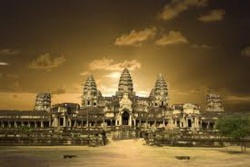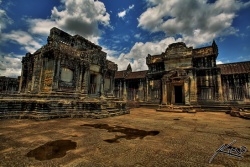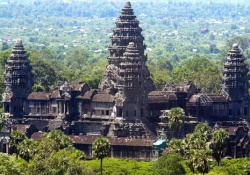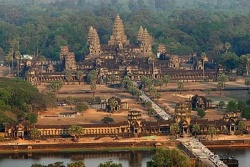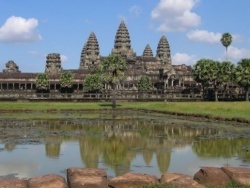Angkor
Brief Description
Angkor is one of the most important archaeological sites in South-East Asia. Stretching over some 400 km2, including forested area, Angkor Archaeological Park contains the magnificent remains of the different capitals of the
Khmer Empire, from the 9th to the 15th century. They include the famous Temple of Angkor Wat and, at Angkor Thom, the Bayon Temple with its countless sculptural decorations. UNESCO has set up a wide-ranging programme to safeguard this symbolic site and its surroundings.
Brief synthesis
Angkor, in Cambodia’s northern province of Siem Reap, is one of the most important archaeological sites of Southeast Asia. It extends over approximately 400 square kilometres and consists of scores of temples, hydraulic structures (basins, dykes, reservoirs, canals) as well as communication routes. For several centuries Angkor, was the centre of the Khmer
Kingdom. With impressive monuments, several different ancient urban plans and large water reservoirs, the site is a unique Concentration of features testifying to an exceptional civilization. Temples such as Angkor Wat, the Bayon, Preah Khan and Ta Prohm, exemplars of Khmer architecture, are closely linked to their geographical context as well
as being imbued with symbolic significance. The architecture and layout of the successive capitals bear witness to a high level of social Order and ranking within the Khmer Empire. Angkor is therefore a major site exemplifying
cultural, religious and symbolic values, as well as containing high architectural, archaeological and artistic significance.
The park is inhabited, and many villages, some of whom the ancestors are dating back to the Angkor period are scattered throughout the park. The population practices agriculture and more specifically rice cultivation.
Criterion (i): The Angkor complex represents the entire range of Khmer Art from the 9th to the 14th centuries, and includes a number of indisputable artistic masterpieces (e.g. Angkor Wat, the Bayon, Banteay Srei).
Criterion (ii): The influence of Khmer Art as developed at Angkor was a profound one over much of South-east Asia and played a fundamental role in its distinctive Evolution.
Criterion (iii): The Khmer Empire of the 9th-14th centuries encompassed much of South-east Asia and played a formative role in the political and cultural development of the region. All that remains of that civilization is its rich heritage of cult structures in brick and stone.
Criterion (iv): Khmer architecture evolved largely from that of the Indian sub-continent, from which it soon became clearly distinct as it developed its own special characteristics, some independently evolved and others acquired from neighboring cultural traditions. The result was a new artistic horizon in oriental Art and architecture.
Integrity
The Angkor complex encompasses all major architectural buildings and hydrological engineering systems from the Khmer period and most of these “barays” and canals still exist today. All the individual aspects illustrate the intactness of the site very much reflecting the splendor of the cities that once were. The site integrity however, is put under dual pressures:
- endogenous: exerted by more than 100,000 inhabitants distributed over 112 historic settlements scattered over the site, who constantly try to expand their dwelling areas;
- exogenous: related to the proximity of the town of Siem Reap, the seat of the province and a tourism hub.
Authenticity
Previous conservation and restoration works at Angkor between 1907 and 1992, especially by the École Française d’Extrême-Orient (EFEO), the Archaeological Survey of India, the Polish conservation Body PKZ, and the World Monuments Fund have had no
significant impact on the overall authenticity of the monuments that make up the Angkor complex and do not obtrude upon the overall impression gained from individual monuments.
Protection and management requirements
The property is legally protected by the Royal Decree on the Zoning of the Region of Siem Reap/Angkor adopted on 28 May 1994 and the Law on the protection of the natural and cultural heritage promulgated on 25 January 1996, the Royal Decree on the creation of the APSARA National Authority (Authority for the protection of the site and the management of the Angkor Region)
adopted on 19 February 1995, the No. 70 SSR government Decision, dated 16 September 2004 providing for land‐use in the Angkor Park: “All lands located in zone 1 and 2 of the Angkor site are State properties”, and the sub-decree No. 50 ANK/BK on the organisation and functioning of the APSARA National Authority adopted on 9 May 2008, specifically provided for the establishment of a Department of Land‐use and Habitat Management in the Angkor Park.
In Order to strengthen and to clarify the ownership and building codes in the protected zones 1 and 2, boundary posts have been put in 2004 and 2009 and the action was completed in 2012.
As off 1993, the ICC-Angkor (International Coordinating Committee for the Safeguarding and Development of the historic site of Angkor) created on 13 October 1993, ensures the coordination of the successive scientific, restoration and conservation related projects, executed
by the Royal Cambodian Government and its international partners. It ensures the Consistency of the various projects, and defines, when necessary, technical and financial standards and calls the attention of all the concerned parties when required. It also contributes to the overall management of the property and its sustainable development.
The successful conservation of the property by the APSARA National Authority, monitored by the ICC-Angkor, was crowned by the removal of the property from the World Heritage List in danger in 2004.
Angkor is one of the largest archaeological sites in operation in the World. Tourism represents an enormous economic potential but it can also generate irreparable destructions of the tangible as well as intangible cultural heritage. Many research projects have been undertaken, since the international safeguarding program was first launched in 1993.The scientific objectives
of the research (e.g. anthropological studies on socio-economic conditions) result in a better Knowledge and understanding of the history of the site, and its inhabitants that constitute a rich exceptional legacy of the intangible heritage. The purpose is to associate the “intangible culture” to the enhancement of the monuments in Order to
sensitize the local population to the importance and necessity of its protection and preservation and assist in the development of the site as Angkor is a living heritage site where Khmer people in general, but especially the local population, are known to be particularly conservative with Respect to ancestral traditions and where they adhere to a great number of archaic
cultural practices that have disappeared elsewhere. The inhabitants venerate the temple Deities and organize ceremonies and Rituals in their honor, involving Prayers, traditional Music and dance. Moreover,
the Angkor Archaeological Park is very rich in medicinal Plants, used by the local population for treatment of diseases. The Plants are prepared and then brought to different temple sites for Blessing by the
Gods. The Preah Khan temple is considered to have been a university of Medicine and the NeakPoan an ancient hospital. These aspects of intangible heritage are further enriched by the traditional textile and basket
weaving practices and palm sugar production, which all result in products that are being sold on local markets and to the tourists, thus contributing to the sustainable development and Livelihood of the population living in and around the World Heritage site.
A Public Investigation Unit was created as « measure instrument » for identifying the needs, expectations and behaviors of visitors in Order to set policies, monitor its Evolution, prepare a flux management policy and promote the unknown sites.
The management of the Angkor Site, which is inhabited, also takes into consideration the population living in the property by associating them to the tourist economic growth in Order to strive for sustainable development and poverty reduction.
Two major contributions supporting the APSARA National Authority in this matter are:
- The Angkor Management Plan (AMP) and Community Development Participation Project (CDPP), a bilateral cooperation with the Government of New Zealand. The AMP helps the APSARA National Authority to reorganize and strengthen the institutional aspects, and the CDPP prepares the land use map with an experimental participation of the communities and supports small projects related to tourist development in Order to improve the income of villagers living in the protected zones;
- The Heritage Management Framework composed of a Tourism Management Plan and a Risk map on monuments and natural resources; a multilateral cooperation with the Government of Australia and UNESCO. Preliminary analytical and planning work for the
management strategy will take into account the necessity to preserve the special atmosphere of Angkor. All decisions must guarantee physical, Spiritual, and emotional accessibility to the site for the visitors.
Long Description
Angkor is one of the most important archaeological sites in South-East Asia. It contains the magnificent remains of the different capitals of the Khmer Empire, from the 9th to the 15th centuries. The influence of Khmer Art, as developed at Angkor, was a profound one over much of South-East Asia and played a fundamental role in
its distinctive Evolution. Khmer architecture evolved largely from that of the Indian subcontinent, from which it soon became clearly distinct as it developed its own special characteristics, some independently evolved and others acquired from neighbouring cultural traditions. The result was a new artistic horizon in oriental Art and architecture.
At the beginning of the 9th century the two states that covered the territory of modern Cambodia were united by Jayavarman II, who laid the foundations of the Khmer Empire, the major Power in south-east Asia for some five centuries. One of the
sites was in central Cambodia, to the north of Tonle Sap (Great Lake), where half a century later Jayavarman's son, Yashovarman, was to establish Yashodapura (later called Angkor), the permanent capital of the Khmer Empire until the 15th century.
The first city conformed with the classic Form of Khmer capital with certain fundamental elements: a defensive bank and ditch with a state temple at its centre, built from brick or stone, and a wooden palace. There would also have been many secular buildings, constructed almost entirely of wood, in and around the enceinte. The state temple at Roluos, the
Bakong, and the temple built in memory of the royal ancestors, Preah Koe erected around 880. Another essential feature of a Khmer capital, a large reservoir, was added a decade later, with in its centre a third temple built to the north-west of Roluos, around the hill of Phnom Bakeng, now known as the Eastern Baray.
The second capital at Angkor was built by Rajendravarman in the 960s, the state temple being situated at Pre Rup. He also constructed a temple, the Eastern Mebon, on an artificial island in the centre of the Eastern Baray. During his reign he built the exquisite temple of Banteay Srei. Rajendravarman's son, Jayavarman V, abandoned the Pre Rup site in favour of a new location
with its state temple at Ta Kev, which was consecrated around 1000. Shortly afterwards he was overthrown by Suryavarman I, who was responsible for erecting the formidable fortifications around his Royal Palace and state temple, the Phimeanakas, and also for the construction of the great Western Baray.
In 1050 his successor created a new and more impressive state temple, the Baphuon. The succeeding rulers left little traces in the Form of monumental buildings, and it was not until the accession of Suryavarman II in 1113 that the next great phase of building began. He was responsible for the greatest of all Khmer monuments, Angkor Vat, set within an extensive
enclosure and dedicated to Vishnu. The Death of Suryavarman II, around 1150, was followed by a period of internal strife and external pressure, culminating in 1177 with the sack of Angkor by the Chams. The situation was
restored by Jayavarman VII, who celebrated his military success by creating yet another capital at Angkor Thorn and launching an unprecedented building campaign. His state temple was the towering Bayon, dedicated to Buddha.
Another significant element of the Angkor complex is the irrigation system of the region based on the great reservoirs, which provided the economic infrastructure for the successive Khmer capitals and their rulers.
Historical Description
At the beginning of the 9th century AD the two states that covered the territory of modern Cambodia were united by Jayavarman II. who laid the foundations of the Khmer Empire, which was the major Power in south-east Asia for nearly five centuries. One of the sites where his court resided for some years was in central Cambodia, to the north of Tonle Sap
(The Great Lake), where half a century later Jayavarman's son, Yashovarman, was to establish Yashodapura, the permanent capital of the Khmer Empire until the 15th century. It was later given the Name Angkor (from the Sanskrit "nagara", meaning city or capital).
The first capital was at latter-day Roluos, itself a pre-Angkorian capital, Hariharalaya. This conformed with the classic Form of Khmer capital. This comprised certain fundamental elements: a defensive bank and ditch with a state temple at its centre built in brick or stone, and a wooden palace. Leading dignitaries would also build temples, both inside and
outside the enceinte, which were dedicated, like the state temple, to Hindu divinities, notably Shiva. There would also have been many secular buildings, constructed almost entirely of wood, in and around the enceinte. The state temple
at Roluos, the Bakong, and the temple built in memory of the royal ancestors, Preah Koe erected around 880. Another essential feature of a Khmer capital, a large reservoir, was added a decade later, with in its centre a third temple. Lolei.
Yashodapura was built to the north-west of Roluos, around the hill of Phnom Bakeng. The enclosure was square, each side Measuring 4km, and it was equipped with a vast reservoir (baray) Measuring 7km by 1.8km, now known as the Eastern Baray. The state temple was built at the summit of Phnom Bakeng around 900. Following a short period when the Khmer capital was transferred to Koh Ker,
some 60km north-east of Angkor, the second capital at Angkor proper was built by Rajendravarman in the 960s. the state temple being situated at Pre Rup. He alsoconstructed a temple, the Eastern Mebon, on an artificial island in the centre
of the Eastern Baray. During his reign Rajendravarman's Guru built the exquisite temple of Banteay Srei, some 25 km north-east of Angkor.
Rajendravarman's son. Jayavarman V, abandoned the Pre Rup site in favour of a new location. with its state temple at Ta Kev. which was consecrated around 1000. Shortly afterwards he was overthrown by Suryavarman I, who was responsible for the formidable fortifications around his Royal Palace and state temple, the Phimeanakas, and also for the construction of the
great Western Baray, extending over an area of 8x2.5km. In 1050 his successor created a new and more impressive state temple, the Baphuon, to the north of the temple.
The succeeding rulers left little traces in the Form of monumental buildings, and it was not until the accession of Suryavarman II in 1113 that the next great phase of building began. It was he who was responsible for the greatest of all Khmer monuments, Angkor Vat, set within an extensive enclosure and dedicated to Vishnu. Among other important monuments dating from this period are Thommanon and Chau Say Tevoda.
The Death of Suryavarman II around 1150 was followed by a period of internal strife and external pressure, culminating in 1177 with the sack of Angkor by the Chams. The situation was restored by [[Jayavarman
VII]], who celebrated his military success by creating yet another capital at Angkor Thorn and launching an unprecedented building campaign. His state temple was the towering Bayon (dedicated to Buddha): among the many other monuments of Jayavarman VII's reign are Ta Prohm, Preah Khan, Ta Som, and Banteay Prei.
Such was the grandeur of this capital that none of Jayavarman VII's successors saw fit to replace it. Nor were there any major monumental additions between his Death around 1200 and the end of the Khmer Empire in the first half of the 15th century.
The Angkor group, including Roluos and Banteay Srei, has to be treated as an ensemble which steadily grew over some three centuries, Masterpieces such as the Bayon and Angkor Vat have to be seen in their contexts and integrated with the temples and other
constructions, particularly the great reservoirs. It is also essential to take into consideration that the areas of jungle between the brick and stone monuments constitute a reserve of buried archaeological remains of immense importance
in the study and interpretation of Khmer culture. Another significant element of the Angkor complex is the irrigation system of the region based on the great reservoirs, which provided the economic infrastructure for the successive Khmer capitals and their rulers. a .
